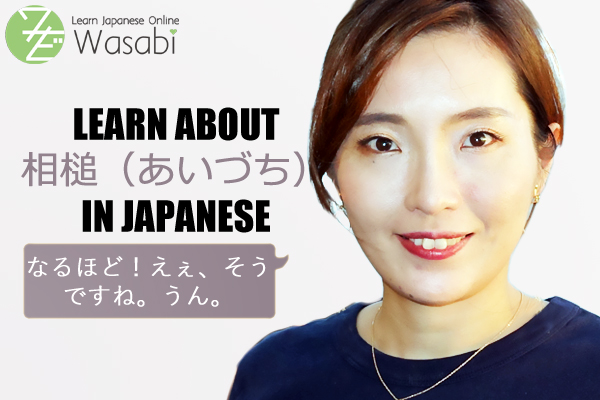How to use “Aizuchi” in Japanese
Welcome back to another “Video & Article” series, this time for another live-stream with tutor Erika. In this live-stream we took a look at “Aizuchi” in Japanese. Aizuchi are filler words or words said/sounds made to indicate one is participating in the conversation. They are used in conversational Japanese. In this article, we will introduce some Aizuchi and give example conversation snippets to help you understand them.
| Table of Contents [Introduction] [Aizuchi] [Examples] |
[Introduction]
Have you ever heard of “そだね” in Japanese? Actually, the Japanese women’s curling team won the Bronze medal during the Winter olympics this year. During matches and television interviews, they kept on saying “そだね”, which is a Hokkaido dialect for “そうだね”. This short phrase became so popular that the media started to call the team “そだね Japan”.
“そだね”, or the normal form, “そうだね”, are so-called “相槌
” (Aizuchi). In today’s article, you will learn what Aizuchi are, which Aizuchi there are, and how to use them!
[adsense]
[Aizuchi]
Aizuchi refer to the frequent interjections (words, phrases or sounds) that people use during a conversation to indicate to the person they are talking to that they are paying attention and/or understanding them. Aizuchi are meant to reassure the speaker and show the listener’s active participation in a conversation or discussion.
In English, some “Aizuchi” would be “Yeah, yeah”, “Yeah, ok”, “Got it”, “Yep”, “Uhuh”, or “Go on”, often rather sounds or short words. In Japanese, Aizuchi tend to be more pronounced.
[Examples]
First of all: “はい”. “はい” is the most common and polite word frequently used as an “Aizuchi”. Other variations include “うん”, which you can use with friends, or “ええ”, which is also used in business situations.
You can identify these words as “Aizuchi”, because even though they technically all mean “Yes”, they are not meant as “Yes, I agree” when used in a conversation, but as “Yes, I am listening to you”. Someone could keep on saying “うん” or “はい” while listening to you and still decline a possible proposition you made at the end.
Another common Aizuchi is “そうですね”. “そうですね” can be used to show your agreement to the person you’re speaking with, or just simply your attention during the conversation. It translates to “Yes, you’re right”, or “Yes, it is”. But sometimes, it is simply used as a filler word before starting a sentence, in which case it could also be translated as “I see”.
Example:
昨日のパーティーは楽しかったですか?
Did you enjoy the party last night?
そうですね。とても楽しかったです!
Yes, it was a lot of fun!
明日は東京へ行きますか?
Are you going to Tokyo tomorrow?
そうですね。明日行きます。
Yes, that’s right. I will go tomorrow.
With friends, you can use “そうだね” (or “そだね”, as the curling team said!). In Kansai, including Osaka and Kyoto, you will also hear variations like “そうやね”, “そやな” or “せやな”.
So, depending on your level of politeness and the dialect spoken, there are many variations of “そうですね”.
Example:
昨日の映画おもしろかったよね?
The movie we watched yesterday was fun, right?
うん、そうやね!
Yeah, it sure was!
今からスタバ行かない?
Wanna go to Starbucks now?
そやね。
Sure.
Have you ever heard the phrase “それな”? “それな” is the latest slang used in Japanese. It’s a very casual expression, and many adults don’t even understand what it means or how to use it. You may have heard this expression in some newer anime.
“それな” is often used by Japanese students, especially on social media. A similar English slang would be replying to something relatable with “Same!” or “Literally same!”.
Example:
めっちゃお腹すいた!
I’m super hungry!
それな!
Same!
The last filler word or “Aizuchi” we will introduce today is “なるほど”. “なるほど” means “I see” and is used when you suddenly understand something you didn’t before. It can also be used as a filler while you are thinking of your response.
Example:
ゴールデンウィークどこ行こうかな?
Where should we go for Golden Week?
カリブ海綺麗だからカンクンおすすめだよ!
The Caribbean sea is beautiful, so I recommend Cancun!
なるほど。それいいね!
I see. That sounds great!
“なるほど” can be used to nod and show your agreement and understanding. There are many, many other Aizuchi out there. Listen closely to conversations and try to find them!
That’s it for today. If you have any questions, you can always clear them up by booking a lesson with one of our native Japanese tutors. See you next time!
| 女子 | Woman, girl |
| 相槌 | Aizuchi, back-channeling |
| 沢山 | A lot, many, much |
| 流れる | To stream, to flow, to run (on TV) |
| 言葉 | Word, words, language |
| 流行 | Popular |





